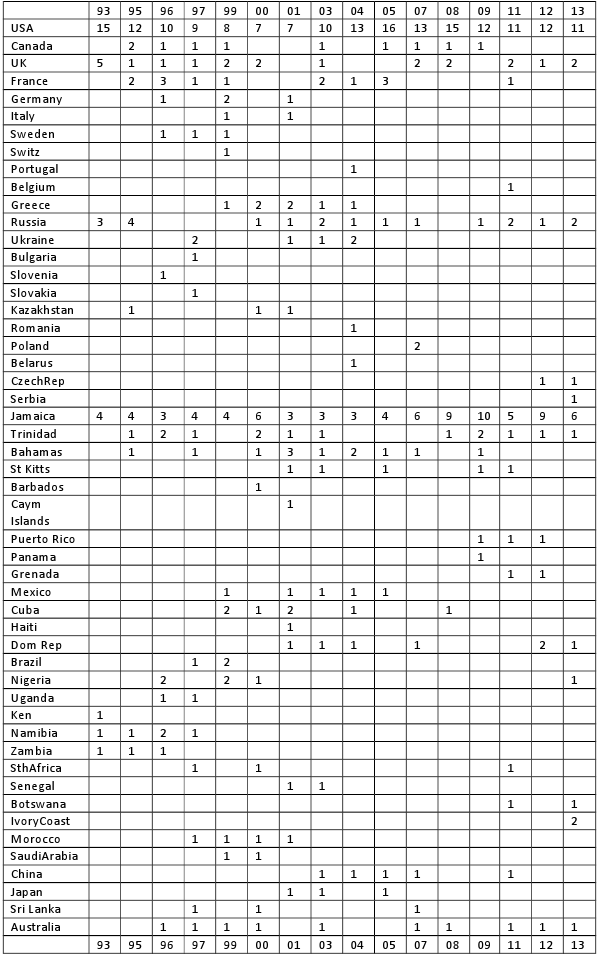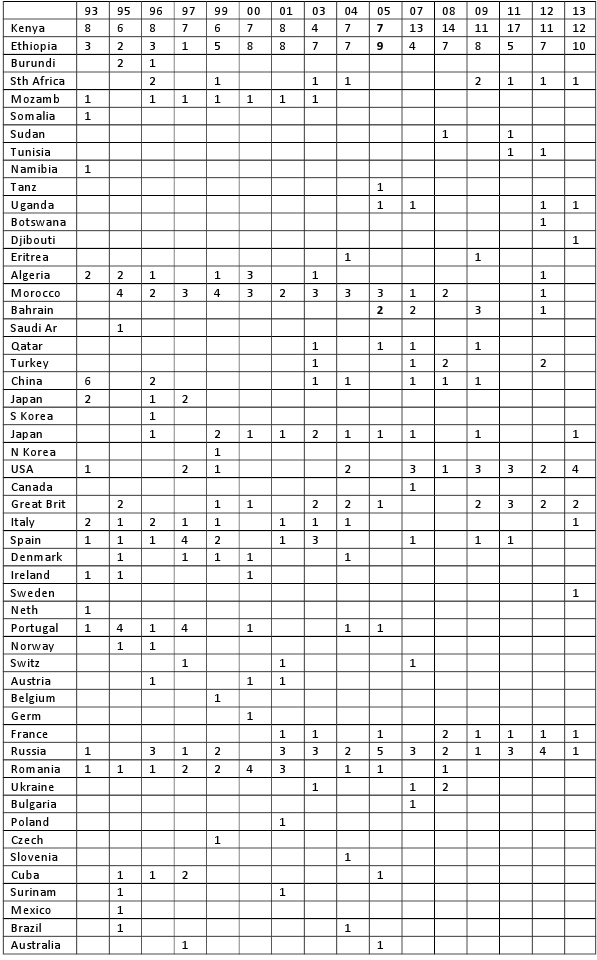How extensive is testing for banned PEDs with regard to running, one of the few major individual sports where both rich and poor nations share success at global championships (Olympic Games and World Championships)?
This article discusses recent trends in terms of national medals won, along with allegations made about lax attitudes by some nations to testing for banned PEDs.
As Tables 1 and 2 indicate, it is difficult to win many running medals, albeit that individual medals won by nations are subject to change given that improving technology and intelligence gathering can lead to later disqualification.
Advertisement
Table 1, which focuses on sprint events (100m to 400m hurdles) from 1993-2013, indicates that few nations win more than a couple of individual medals per championship, although the USA and Jamaica are exceptions.
Table 1: National sprint medals won by males and females at global athletics championships 1993-2013

With regard to longer events (800m to the marathon), Table 2 also indicates that only a few nations regularly win more than 3 medals at a single championship, although Kenya and Ethiopia are exceptions
Table 2: National medals longer distances won at global athletics championships 1993-2013

Advertisement
There are only a few nations that have significantly improved their medal haul since 1993. For example, Jamaica, which averaged 3.8 sprint medals per global championship in five championships from 1993 to 1999, has averaged 7.8 since 2008. In the longer events, Kenya, which averaged 7 medals during the 1993-99 period, has won an average 13 per medals since 2008. Similarly, Ethiopia's average medal haul per championship has improved from 2.8 to 7.4 for the same periods.
Some may point to a link between banned PED use and recent global success, with IAAF all-time lists (as of June 23, 2014) indicating that Jamaica has produced 5 of the 10 all-time fastest male 100m runners, and Kenya 8 of the fastest 10 marathon performers, all since 2008.
Dick Pound, the former head of WADA, has doubted the ability of the IAAF to test Jamaican athletes adequately as the 'IAAF very seldom go to the island', and on arrival there, it's very hard to find people'.
With regard to Kenya, it was reported in 2012 that its athletes were not blood tested at the domestic level, despite blood testing being crucial to help detect the endurance booster erythropoietin (EPO), blood transfusions, and human growth hormone. While the IAAF indicated it only took blood samples when Kenyans compete or train abroad, WADA highlighted the difficulty of testing in Kenya because of its remote location, transport difficulties, and costs (Jacquelin Magnay and Simon Hart, 'Wada says there is no blood testing for EPO in Kenya's big training centre for distance runners', The Telegraph, 31 Oct 2012).
In May 2013, research (funded by WADA) indicated that both Kenyan and Scottish runners improved their 3000-meter times by an average of 5% after taking EPO for four weeks with 3% improvement still evident after stopping use for four weeks. This was despite the Kenyans having higher hemoglobin and hematocrit values, markers that are related to red blood cell quality and density, and being based in Eldoret (elevation of close to 8,000 feet) compared to sea level for the Scots (Scott Douglas; Study: Kenyans Get Performance Boost From EPO, Runnersworld.com, May 31, 2013).
Tougher drug testing elsewhere may also explain why some countries have experienced a dramatic decline in terms of global running medals won. For example, after a unified Germany won 3 sprint medals at the 1991 World championships, it has won just 5 running medals since 1993 in 16 global championships (none since 2001).
Similarly, Western European countries, which won 26 sprint medals during the 1990s, have won just 9 medals since 2008. In the longer events, the decline has been from 40 to 19 medals for the same periods.
But it would be a mistake to imply that winning medals depends merely on the extent and scope of drug tests, including both in-competition-testing (ICT) and out-of-competition testing (OCT). For example, USA sprinters, subject to an extensive testing program which has caught several of its champions), have won an average 12.2 sprint medals per championship since 2008 compared to 10.8 during the 1990s (see table 1).
Testing loopholes remain evident. During 2013, WADA's director general David Howman noted the need to monitor the ongoing development of designer drugs and the use of smaller doses with regard to synthetic testosterone, HGH and EPO. With hopes for a new 'steroid passport' system, similar to the biological passport, WADA wants to detect changes in athletes' blood given that smaller doses can be undetectable in three to five hours (Colin Armstrong Drug Cheats in Sport Taking Smaller Doses to Avoid Being Caught Out', Addiction Helper, Courtesy of Press Association, Oct. 16, 2013).
It remains essential that all IAAF national affiliates commit to stringent testing for both domestic and international athletes. During 2012, a Kenyan doctor, caught in a sting operation by undercover German television reporters, claimed that foreign athletes came to his high altitude medical practice to access a cocktail of illegal drugs such as steroids, EPO and HGH (Jacquelin Magnay and Simon Hart, Wada says there is no blood testing for EPO in Kenya's big training centre for distance runners', The Telegraph, 31 Oct 2012).
Third, the importance of international testing is not only made evident by Jamaica conducting just 35 OCT for its track and field athletes during 2012, or Kenya conducting none. Rather, 2012 WADA data indicates that only ten national drug testing bodies conducted 200+ OCT urine tests, 19 100+, and 31 50+. Of OCT blood tests, only six national bodies conducted 50+ OCT, 12 20+ tests, and 16 10+.
Testing by the IAAF is even more crucial for nations who lack the will or resources to adopt an effective testing strategy. While 2012 WADA data indicates that the IAAF was responsible for 5817 of the total 27836 ICT and OCT tests for athletics in 2012 (20.9%), the IAAF's importance with regard to blood OCT was more important with 2215 of 3412 OCT tests (64.9%).
Table 3, which refers to data from the IAAF's Registered Testing Pool, indicates that athletes from Kenya, Ethiopia and Jamaica represent a significant portion of the 525 athletes subject to extensive testing.
Table 3: Selected countries from 2012 IAAF Registered Testing Pool data

Nevertheless, as suggested by Kenya and Ethiopia having a lower proportion of OCT blood tests, IAAF testing can be improved.
Perhaps there should also be a greater use of the Carbon Isotope Ratio (CIR) test, which identifies the presence of synthetic testosterone in the body for up to two weeks, and has a catch rate five times higher than the traditional Testosterone/Epitestosterone Ratio.
Despite Tyson Gay testing positive to the CIR test through urine samples collected by USADA and the IAAF (Admin, 'Tyson Gay Accepts Sanction For Anti-Doping Rule Violation', trackledger.com, May 3, 2014), WADA data indicates that the IAAF only conducted 97 similar tests in 2012.
However, the CIR test is expensive at around $400 in the USA, roughly twice the cost of the T/E ratio test, with its high cost likely to reduce the number of overall tests.
Presently there is an emphasis on longitudinal profiling in which individual athletes' test results are tracked over time. As an athlete's T/E ratio generally varies by less than 30% over time, with other steroid markers in urine samples similarly stable, the CIR is utilised if a T/E abnormality emerges even if under the legal 4-1 ratio.
In the end, the extent of testing does depend on resources and political will.
While WADA has sought to increase OCT in Kenya and Ethiopia with a facility scheduled to open in Eldoret in 2013, by early 2014 not a shovel was in site with a Kenyan committee also indicating that investigations into doping may stall due to lack of funds.
In the case of Jamaica, however, change has occurred. By April 2014, the Jamaica Anti-Doping Commission (JADCO) had announced that it would sign a Joint Training Initiative Agreement for 15 months with the Canadian Centre for Ethics in Sport and WADA in order to refine and upgrade its operational procedures to help improve its system. Along with JADCO receiving a 63% increase in government budgetary support for the 2014/2015 financial year, additional Doping Control Officers are to be recruited and trained to boost personnel.
These actions followed a successful appeal by the three-time Olympic gold medallist Campbell-Brown against a two-year ban on the grounds that strict WADA standards were not followed during her sample collection; eight Jamaicans failing doping test in 2013, the resignation of the entire JADCO board, and revelations by JADCO's former executive director, Renee Anne Shirley, that only one OCT was conducted in the five months leading up to the 2012 Olympics.
To conclude, the IAAF continues to make gains to encourage fairer competition, but resources and political will long remain critical to the task of ongoing improvement. As the evidence stands, there are a number of loopholes that remain exploited by athletes from both rich and poor nations, but the opportunity to cheat is indeed diminishing.